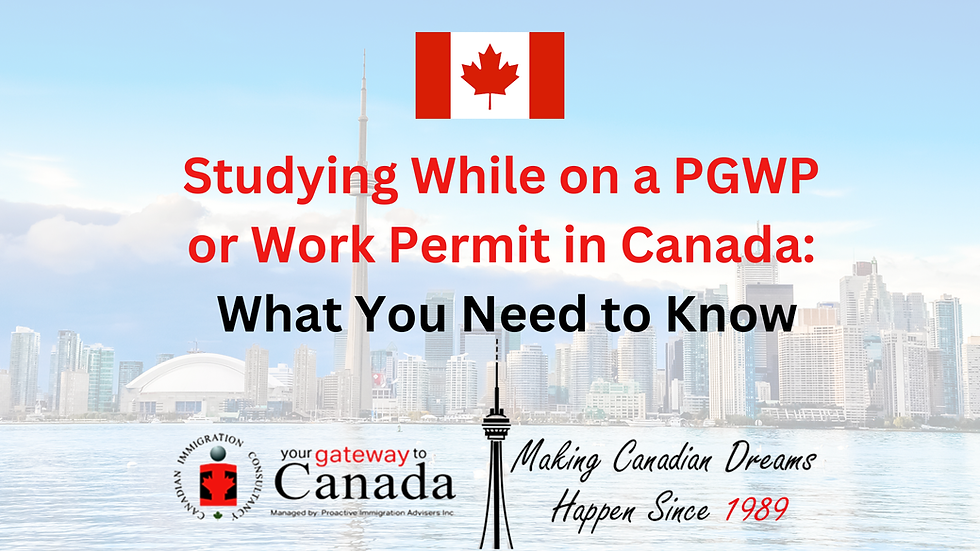Changes to Open Work Permits for Family Members of Temporary Residents: What You Need to Know
- PIACORP Consultancy

- Jan 14
- 4 min read

Ottawa, January 14, 2025 – In a move to enhance the integrity of Canada’s temporary resident programs while addressing labor market needs, the Government of Canada is making important changes to open work permits (OWPs) for family members of international students and foreign workers. These changes, set to take effect on January 21, 2025, aim to refine eligibility criteria and ensure that work permits are aligned with Canada’s economic priorities.
Key Changes to Family Open Work Permits (OWPs)
Effective January 21, 2025, family members of temporary residents—specifically spouses—will face more stringent eligibility requirements when applying for an OWP. These changes will impact both spouses of international students and spouses of foreign workers.
1. Eligibility for Spouses of International Students
OWPs for spouses of international students will now be limited to those whose partners are enrolled in specific academic programs. The new eligibility criteria are as follows:
Master’s Programs: Students enrolled in master’s programs that are at least 16 months in duration.
Doctoral Programs: Spouses of students enrolled in PhD programs will continue to be eligible.
Select Professional Programs: Spouses of students in certain professional programs may also qualify, depending on program specifics.
This means that spouses of international students in short-term programs or those pursuing certificates may no longer be eligible for an open work permit under the updated rules.
2. Eligibility for Spouses of Foreign Workers
Similarly, the government is limiting the eligibility for spouses of foreign workers to those employed in specific fields. In particular, the new rules will apply to workers in occupations classified under the National Occupational Classification (NOC) as follows:
TEER 0 or 1 Occupations: These are typically managerial or professional roles, which require a high level of skill.
Select TEER 2 or 3 Occupations: Occupations in sectors experiencing labor shortages or areas that align with Canadian government priorities will also qualify. This includes sectors such as:
Natural and applied sciences
Construction
Healthcare
Natural resources
Education
Sports
Military
The full list of eligible occupations will be published on January 21, 2025.
Additionally, the foreign worker must have at least 16 months remaining on their work permit when their spouse applies for the OWP. Importantly, dependent children of foreign workers will no longer be eligible for a family OWP under the new rules.
3. What Happens to Existing Open Work Permits?
For individuals who have already received an open work permit under the previous criteria, their permits will remain valid, even if the conditions change. In certain cases, where family members require an extension or renewal, they may apply for a new work permit, provided they meet the following conditions:
Same Criteria: The applicant must apply under the same eligibility criteria as the current permit holder.
Duration Match: The requested duration for the renewed work permit must align with the principal applicant's study or work permit.
These provisions ensure that those currently holding valid work permits are not immediately impacted by the new rules.
4. Exemptions and Other Considerations
Spouses of Workers Covered by Free-Trade Agreements: Spouses of foreign workers covered by specific free-trade agreements (e.g., the Canada-United States-Mexico Agreement or CUSMA) will not be affected by these changes and will retain eligibility for an open work permit.
Spouses Transitioning to Permanent Residency: Individuals in the process of transitioning to permanent residency will also be exempt from these restrictions.
For those family members who will no longer qualify for an OWP under the new guidelines, there remains the option to apply for other types of work permits, provided they meet the general eligibility requirements for Canada’s work permit programs.
Why the Changes?
These changes reflect Canada’s broader efforts to improve the efficiency of its temporary resident programs while focusing on the country’s economic priorities. By aligning open work permits with occupations in high-demand sectors, the government aims to ensure that foreign workers contribute to sectors where their skills are needed most. Additionally, by limiting the eligibility for spouses of international students and foreign workers, the government is seeking to ensure that family members of temporary residents are not unintentionally competing for jobs in a labor market that’s already facing challenges.
What Should You Do Next?
If you’re a family member of an international student or foreign worker and are considering applying for an open work permit, it’s important to review the new eligibility criteria to determine if you qualify. If your spouse or partner is enrolled in an eligible program or employed in an in-demand occupation, you may still be able to apply for a family OWP. However, if you no longer meet the criteria under the new rules, you can explore other options, such as applying for a closed work permit if you qualify for one under Canada’s general work permit programs.
As always, it’s a good idea to consult the official Immigration, Refugees and Citizenship Canada (IRCC) website or seek advice from a qualified immigration consultant to ensure you have the latest information and are following the correct application process.
Final Thoughts
The changes to open work permits for family members of temporary residents mark a significant shift in Canada’s immigration policy. While some individuals may be impacted by these new rules, there are still avenues for many to continue contributing to the Canadian economy through work permits. Staying informed and prepared is key to navigating these changes successfully.
Source: IRCC Website








Comments